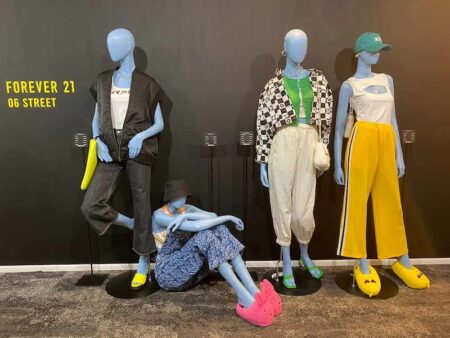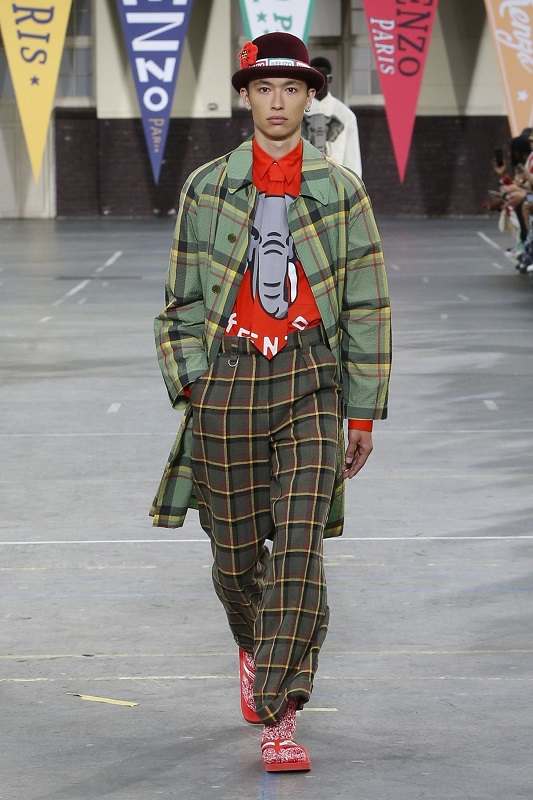

Courtesy of KENZO
A model walks in an outfit by Nigo at the Japanese designer’s debut show as Kenzo’s artistic director in Paris in January 2022.
12:00 JST, Jan 6, 2023
A new year has begun and with it a new chapter in the history of the Japanese fashion industry. To think about where we are going, it helps to remember where we have been. So here’s a look back at the major developments in 2022 that will likely continue to shape the fashion landscape in 2023. Newsmakers include big-name designers, fast fashion companies, and the Japanese trading company Itochu.
the torch is passed
The deaths in 2022 of Hanae Mori and Issey Miyake, two of the most iconic Japanese designers who have gained international fame, were heavy losses for the fashion industry in Japan. But last year also saw Nigo, who started out as a popular designer in Tokyo’s “Ura-Harajuku” (Harajuku lane) scene, present his first collection as art director of Kenzo, an LVMH brand, in Paris in January.
I really felt the changes of the times as I watched Nigo become the first Japanese designer to win the position of art director of a brand managed by LVMH as legends like Mori and Miyake went down in history.
Looking abroad, Gucci announced in November that Alessandro Michele, who expanded Gucci into a $10 billion brand, would step down as chief creative officer, a role he has held since 2015. In the same month, Tom Ford, who established the role As an artistic director running a luxury brand with Gucci in the 1990s, he said he would sell his own brand, Tom Ford, to the licensee of his cosmetics brand, Estee Lauder. The deal was valued at $2.8 billion.
Also in November, Raf Simons, co-creative director of Prada along with Miuccia Prada, revealed that he would no longer make collections for his eponymous Raf Simons label. I was surprised to learn that Simons, one of the most creative designers today, would focus on being a mercenary for a luxury brand. These news drive home the changes in the role of fashion designers.
The fashion industry is currently eagerly awaiting the news of who will succeed Michele, creator of a never-before-seen Gucci boom. Meanwhile, the position of Louis Vuitton’s men’s artistic director, held by Virgil Abloh, who died suddenly in November 2021 at age 41, also remains vacant.
Who will occupy these two main positions? This is probably the industry’s biggest concern going into 2023.
The impact of Shein’s fast fashion
It was shocking that H&M Group, which ranked second in the industry for its SPA (private label specialty clothing retailer) business, also known as fast fashion, said on November 30 that it would lay off 1,500 employees.
Among the top four SPA brands, led by Zara, GAP was the first to start slowing down, even before the pandemic began. H&M is now likely to follow suit, meaning only two of the Big Four have successfully weathered the pandemic: Inditex, whose core brand is Zara, and Fast Retailing Co., whose core brand is Uniqlo, which ranks third. place.
And now there is Shein, a rising star in the SPA market. The brand is managed by Roadget Business Pte. Ltd., a Chinese company based in Singapore. Since the company is not publicly traded, its details are a mystery.
Shein has an aggressive strategy for Japan. In 2022, the brand participated in the Tokyo Girls Collection in March, opened a pop-up store in Osaka in October, and launched a showroom on Cat Street in Harajuku, Tokyo in November.
Shein is a completely D2C (direct to consumer) brand. This means that in the showroom, customers wishing to purchase a Shein product must do so online via a QR code. It has been said for some time that the next SPA market leader will have a D2C system, and that change has already started in Japan. Watch for its effects in 2023.
Itochu’s Challenges
Three years have passed since the pandemic began. In Japan, Itochu Corp. is the company that has taken proactive measures more than any other in the past year, with an eye on the coming days after COVID-19. The trading company made particularly aggressive moves in the field of sportswear. In April, the company acquired a majority stake in Dome Corp., which represents Under Armor in Japan, and formed a joint management system with the US sportswear company. Itochu also obtained merchandising rights and licensing rights from Reebok in May. In 2019, the company took over Descente Ltd. and improved its management.
This successful experience seems to have given Itochu the belief that there is sales in sports, which encouraged the company to look for more brands in that field. It will be interesting to see if Itochu can break the dominance of Nike, Puma and Asics in 2023.

Courtesy of seventietwo.com
Above: Items from the Spring/Summer 2023 collection for Forever 21, which is returning to Japan with Itochu Corp. as primary licensee and Adastria Co. as sub-licensee
Last year, Itochu also acquired the master license rights to many other brands, including Eddie Bauer, LL Bean, and Forever 21.
Of them, Forever 21 and Eddie Bauer are coming to Japan for the second time. It is a common belief in the fashion industry that second-timers cannot succeed. Will they be able to break that pattern? Following the acquisition of the master license rights to Forever 21, Itochu sublicensed to Adastria Co., and American Rag Cie is now operated by Leon International Inc. on Itochu’s behalf. In addition, Itochu also established a joint venture with Mash Holdings Co. after obtaining the distribution rights for British lifestyle brand Barbour.
In any case, Itochu created quite a stir in the fashion, apparel and sports equipment industry in 2022. The result of the challenges the company has taken on will become apparent from 2023.

akira miura
Miura is a journalist and former editor-in-chief of WWD Japan.
Source: news.google.com